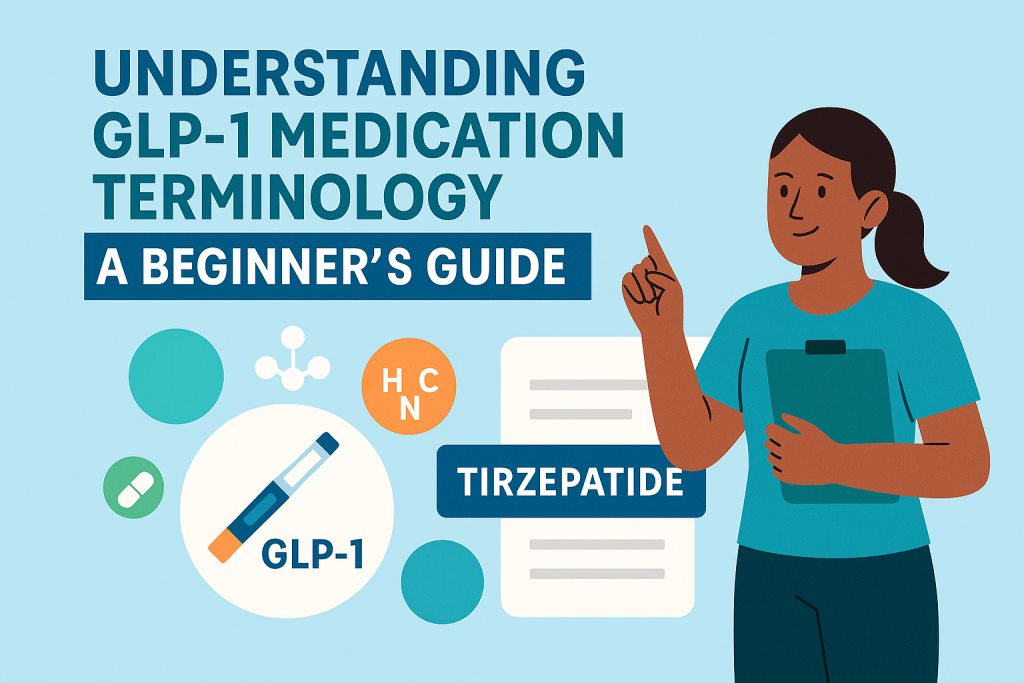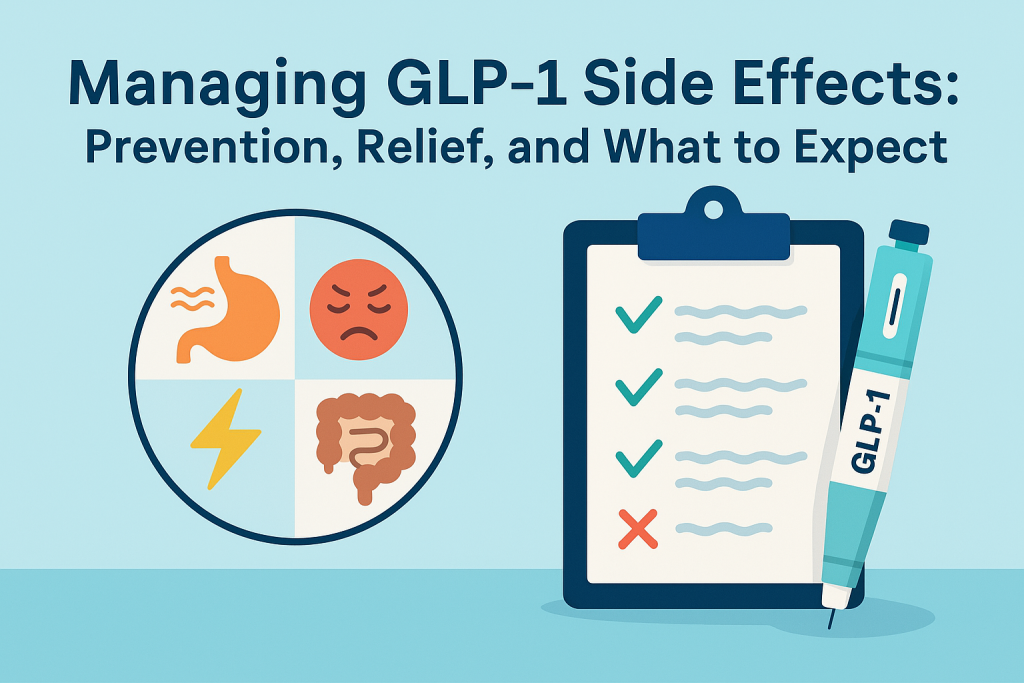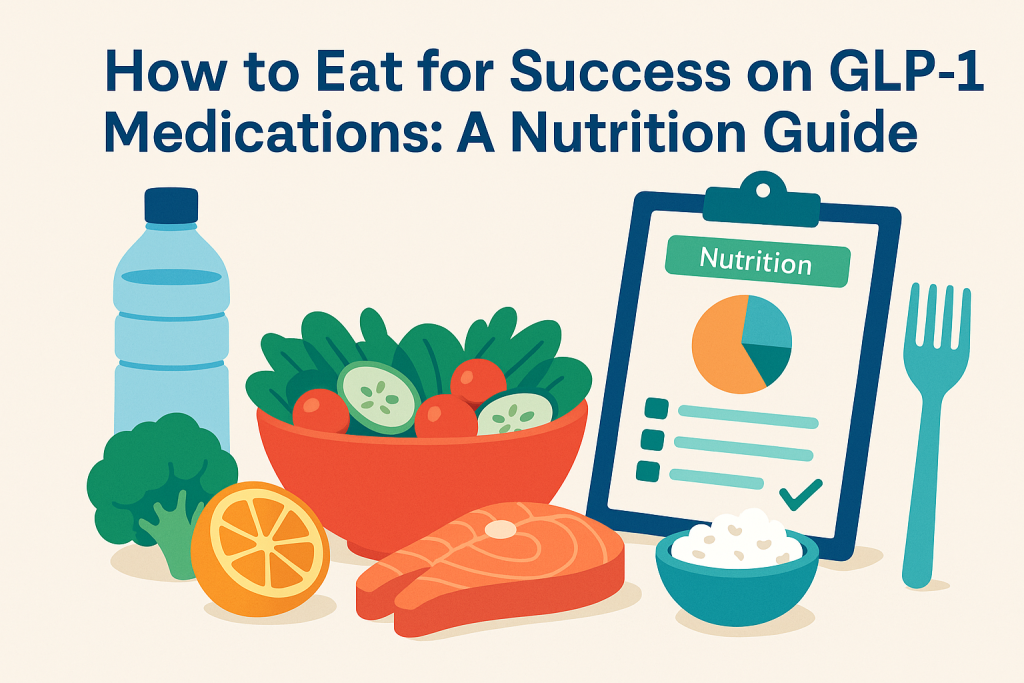If you’re exploring GLP-1 medications, you’ve likely encountered terms like semaglutide, tirzepatide, compounds, and more. With the rise in popularity of these medications for managing weight and diabetes, understanding the terminology can seem overwhelming. This GLP-1 Beginner’s Guide breaks down the essential terms clearly and simply, providing you with the foundational knowledge needed to make informed health decisions.
What Exactly are GLP-1 Medications?
GLP-1 stands for Glucagon-like Peptide-1, a hormone naturally produced by your body in response to eating. Its main roles are to stimulate insulin release, suppress glucagon secretion, slow stomach emptying, and reduce appetite. In essence, GLP-1 helps regulate blood sugar and manage appetite, making it a key focus for treating conditions like type 2 diabetes and obesity.
GLP-1 medications, or GLP-1 receptor agonists, are medications designed to mimic this natural hormone’s effects. They are used primarily to lower blood sugar in people with type 2 diabetes and to aid weight loss in both diabetic and non-diabetic individuals.
Key Terms Explained
1. GLP-1 Receptor Agonist
A GLP-1 receptor agonist is a type of medication that binds to and activates GLP-1 receptors in your body, enhancing insulin secretion, reducing glucagon release, slowing digestion, and promoting satiety. Unlike insulin itself, GLP-1 receptor agonists only stimulate insulin production in response to meals, significantly lowering the risk of hypoglycemia (low blood sugar).
Popular examples of GLP-1 receptor agonists include:
- Semaglutide (Ozempic, Wegovy)
- Liraglutide (Victoza, Saxenda)
- Tirzepatide (Mounjaro, dual-action)
These medications are typically administered via injections, though oral formulations, such as Rybelsus (oral semaglutide), are also available.
2. Semaglutide
Semaglutide is one of the most widely used GLP-1 medications and is known under brand names like Ozempic and Wegovy. Originally approved for managing blood sugar in type 2 diabetes, semaglutide has gained immense popularity due to its impressive weight-loss effects.
- Ozempic is primarily prescribed for diabetes but is commonly used off-label for weight loss due to its efficacy.
- Wegovy is specifically approved by the FDA for chronic weight management.
Semaglutide works by significantly suppressing appetite, slowing digestion, and stabilizing blood sugar levels, allowing users to achieve substantial weight loss, often around 10-15% of their body weight over several months.
3. Tirzepatide
Tirzepatide (brand name: Mounjaro) is a newer GLP-1 medication and offers a unique dual-action mechanism, acting as both a GLP-1 receptor agonist and a glucose-dependent insulinotropic polypeptide (GIP) receptor agonist. This dual mechanism provides additional metabolic benefits, enhancing insulin secretion, reducing glucagon, and further boosting weight loss compared to single-action GLP-1 agonists like semaglutide.
Tirzepatide is currently approved for treating type 2 diabetes, but due to its potent effects, it’s also widely used for weight management. Clinical trials have shown even greater weight loss potential than semaglutide, positioning tirzepatide as an increasingly popular choice among healthcare providers and patients alike.
4. Compound Medications
Compounded medications refer to custom-formulated drugs made by compounding pharmacies. Compounded GLP-1 medications may combine active ingredients or create formulations not commercially available. Patients may opt for compounded medications due to cost, supply issues, or the need for personalized dosing.
However, compounded GLP-1 medications do not undergo the same rigorous FDA approval process as commercial medications, raising concerns about consistency, potency, and safety. It’s crucial to obtain compounded medications only from reputable pharmacies and always under the guidance of a healthcare provider.
5. Ozempic, Wegovy, and Mounjaro – What’s the Difference?
While Ozempic, Wegovy, and Mounjaro all fall under the GLP-1 category, they differ in their primary uses and formulations:
- Ozempic: Originally approved for diabetes, widely used for both blood sugar control and weight management (off-label).
- Wegovy: Specifically approved for long-term weight management and typically prescribed for individuals without diabetes who are overweight or obese.
- Mounjaro (Tirzepatide): Approved for diabetes management, also increasingly recognized for its potent weight-loss capabilities due to its unique dual mechanism.
These differences highlight why understanding terminology is critical, ensuring you select the medication best suited to your health goals and conditions.
6. Generic vs. Brand Name
Understanding the difference between generic and brand-name medications is crucial when navigating GLP-1 treatments. Brand-name drugs are developed by pharmaceutical companies and are marketed under specific names like Ozempic or Wegovy. These drugs are initially protected by patents, preventing other companies from producing the same formulation.
Generic medications are bioequivalent versions of brand-name drugs, manufactured once the original patent expires. Generics must demonstrate the same quality, strength, safety, and efficacy as their branded counterparts but typically cost less. However, in the context of GLP-1 medications, generic options remain limited due to existing patents and exclusivity rights. Currently, patients have fewer generic alternatives, and most available GLP-1 medications are branded, often resulting in higher costs for consumers.
7. Compounded vs. FDA-Approved Medications
Compounded medications are customized formulations created by compounding pharmacies tailored to individual patient needs. In contrast, FDA-approved medications undergo extensive clinical trials and rigorous regulatory processes to ensure safety, efficacy, and consistent quality standards.
Benefits of Compounded Medications:
- Customization of dosage and formulation to individual needs.
- Potential cost savings compared to brand-name medications.
- Availability during shortages of commercial products.
Risks of Compounded Medications:
- Potential variability in potency and quality.
- Lack of stringent FDA regulatory oversight.
- Increased risk of contamination or formulation errors.
Given these risks, it’s crucial to source compounded medications exclusively from reputable and accredited pharmacies and always consult your healthcare provider when considering compounded treatments.
Supporting Terminology
Injection Sites: Best Practices for GLP-1 Injections
Proper injection techniques significantly affect medication efficacy and comfort. Recommended injection sites for GLP-1 medications include:
- Abdomen (avoiding the immediate area around the navel).
- Outer thighs.
- Upper arms (outer back area).
Rotate injection sites regularly to avoid discomfort, reduce skin irritation, and maintain effective absorption. Follow your healthcare provider’s instructions on injection techniques and hygiene practices to minimize risks and maximize treatment effectiveness.
Titration: Gradual Increase of Medication Dose
Titration refers to gradually adjusting the dose of medication to find the optimal balance between efficacy and tolerability. GLP-1 medications typically begin at a low dose, slowly increasing to minimize side effects such as nausea and digestive discomfort. This gradual escalation allows your body to adapt more comfortably, improving adherence and treatment outcomes. Always follow your healthcare provider’s recommended titration schedule closely and communicate openly about any side effects experienced during this process.
Half-Life: Meaning and Relevance for Dosing Schedules
The half-life of a medication is the time it takes for the concentration of the drug in your bloodstream to reduce by half. Understanding half-life helps determine appropriate dosing intervals and ensures optimal therapeutic effects while minimizing side effects. GLP-1 medications vary in half-life duration, influencing their dosing schedules:
- Shorter half-life medications may require more frequent dosing.
- Longer half-life medications, such as once-weekly semaglutide, allow for less frequent administration, enhancing convenience and adherence.
Recognizing the half-life of your specific medication aids in setting realistic expectations regarding treatment effects, side effects management, and proper adherence to dosing instructions.
Common Misunderstandings Clarified
As GLP-1 medications become increasingly popular, several misconceptions about their safety, effectiveness, and long-term use have emerged. Clearing up these myths and misunderstandings helps you approach treatment with accurate expectations and greater confidence.
Myth: GLP-1 Medications are Unsafe for Long-Term Use
The safety profile of GLP-1 medications is robust, backed by extensive clinical trials and ongoing real-world studies. While side effects can occur, serious complications are rare. Regular monitoring by your healthcare provider ensures any potential issues are caught early and managed effectively, allowing safe long-term use.
Myth: Effectiveness Declines Over Time
Contrary to belief, GLP-1 medications generally maintain their effectiveness over extended periods. However, individual responses can vary, and some patients may experience plateaus in their progress. Adjusting dosage or addressing lifestyle factors often resolves these plateaus, enhancing continued effectiveness.
Myth: Switching GLP-1 Medications is Risky
Switching between GLP-1 medications under medical supervision is usually safe and common practice, especially if you’re experiencing insufficient results or bothersome side effects. Always consult your healthcare provider before making any medication adjustments to ensure proper transition and continued efficacy.
Myth: Insurance Doesn’t Cover GLP-1 Medications
Many insurance plans, including Medicare and private insurers, do cover GLP-1 medications, especially for patients diagnosed with type 2 diabetes or clinically significant obesity. Coverage varies widely, so it is crucial to verify your specific plan details and communicate with your healthcare provider about documentation and prescription requirements.
Myth: Off-Label Use of GLP-1 Medications is Unsafe
While FDA-approved indications provide clear guidance on medication use, off-label prescribing—such as using diabetes-approved GLP-1 medications for weight loss—is common and often supported by medical research. Healthcare providers frequently prescribe medications off-label when evidence supports effectiveness and safety. Always discuss any off-label medication use thoroughly with your provider to understand potential risks and benefits.
Practical Tips for New Users
Beginning your journey with GLP-1 medications can feel overwhelming. The following practical tips can help ease this transition and support a successful treatment experience:
Approaching Discussions with Your Healthcare Provider
Open and clear communication with your healthcare provider is essential. To make the most of your consultations:
- Prepare a list of questions or concerns beforehand.
- Be transparent about your medical history, current medications, and lifestyle habits.
- Clarify your treatment goals and expectations.
- Discuss potential side effects and management strategies openly.
- Ask about alternative options, including medication switching or adjustments if needed.
Checklist for Starting GLP-1 Therapy
To ensure a smooth start to your GLP-1 medication journey, consider the following essential points:
- Dosage Expectations: Understand your initial dosage and the expected timeline for dose increases. Follow your healthcare provider’s titration schedule closely to minimize side effects.
- Tracking Side Effects: Keep a detailed log of any symptoms or side effects you experience, noting their severity and timing. This log can significantly aid your healthcare provider in adjusting your treatment effectively.
- Nutrition Adjustments: Adopt dietary practices supportive of GLP-1 therapy, such as smaller meal portions, high-fiber foods, adequate protein intake, and regular hydration. These dietary adjustments can enhance medication effectiveness and reduce gastrointestinal side effects.
- Injection Technique and Schedule: Learn the proper technique for injections, rotating injection sites to minimize discomfort and ensure effective absorption. Maintain a consistent injection schedule as advised by your healthcare provider.
- Regular Monitoring: Schedule regular check-ins with your healthcare provider to assess your progress, manage potential side effects, and adjust dosages as needed.
- Support Systems: Establish a support system, either through friends, family, or support groups, to help you stay motivated and accountable.
Adopting these practical tips and proactively addressing potential issues will help you experience greater comfort and effectiveness throughout your GLP-1 medication journey.
How the Pep App Simplifies GLP-1 Medication Management
Effectively managing GLP-1 medications requires attention to detail, consistent tracking, and a structured approach. The Pep app streamlines this process with comprehensive features specifically designed to support your GLP-1 medication journey, making it easier and more effective.
Comprehensive Medication Tracking
Pep’s medication tracking feature ensures you never miss a dose. You can easily log each injection, set up personalized reminders for medication schedules, and track any dosage adjustments recommended by your healthcare provider. This detailed logging helps maintain consistent medication use, optimizing therapeutic effectiveness and minimizing the risk of side effects.
Injection Site Rotation and Management
Correctly rotating injection sites is crucial for avoiding skin irritation and ensuring effective absorption. Pep provides an intuitive interface to log and visualize your injection sites, reminding you to rotate locations consistently. This helps maintain skin integrity and maximizes medication effectiveness.
Symptom and Side Effect Logging
Tracking symptoms and side effects is vital for managing your treatment effectively. Pep allows you to log symptoms such as nausea, constipation, or fatigue easily and clearly. Detailed analytics highlight patterns and trends, empowering you and your healthcare provider to make informed decisions and timely adjustments.
Nutrition and Dietary Tracking
A balanced diet significantly enhances GLP-1 medication effectiveness. Pep’s nutrition tracking feature lets you effortlessly log meals, monitor macronutrients, and assess dietary patterns. This supports optimal nutritional practices that enhance your medication’s efficacy and minimize gastrointestinal side effects.
Hydration Monitoring
Hydration significantly influences the effectiveness and comfort of GLP-1 treatments. Pep’s hydration tracking ensures you consistently monitor and maintain optimal fluid intake, reducing side effects like headaches, fatigue, and constipation.
Holistic Health Management
Beyond medication and nutrition, Pep offers tools to track physical activity, weight changes, and overall health progress. This holistic approach provides a comprehensive overview of your health, enabling targeted lifestyle adjustments to enhance medication effectiveness and overall wellness.
Benefits of Consistent Tracking
Consistent use of the Pep app offers substantial benefits:
- Enhanced medication adherence: Regular reminders and easy logging boost adherence, improving health outcomes.
- Reduced side effects: Early symptom detection and proactive management reduce discomfort and enhance treatment comfort.
- Personalized care: Detailed logs and analytics support more informed consultations and personalized adjustments from your healthcare provider.
- Empowerment and motivation: Visual progress and insights motivate sustained lifestyle changes and treatment compliance.
FAQ: Common Questions for Beginners
Can I switch between GLP-1 medications?
Switching between GLP-1 medications is generally safe and common, especially when experiencing side effects or inadequate results. Always consult your healthcare provider before switching medications to ensure safe transitions and continued effectiveness.
Are compounded medications safe?
Compounded medications can be safe when sourced from reputable pharmacies that adhere to strict quality and safety standards. However, compounded medications lack FDA approval, potentially resulting in variations in quality and effectiveness. Always discuss compounded medication use with your healthcare provider and ensure you obtain them from reliable sources.
How soon can I expect results?
Many users notice initial results, such as reduced appetite or improved blood sugar control, within the first few weeks. Significant weight loss or substantial improvements in blood sugar levels typically become evident within three to six months. Results vary based on individual adherence, lifestyle adjustments, and medication response.
What if I miss a dose?
If you miss a dose, take it as soon as possible unless it’s nearly time for your next scheduled dose. Never double dose. Consult your healthcare provider for specific guidance regarding missed doses, as recommendations may vary based on your medication type and dosage schedule.
Conclusion & Next Steps
Understanding the terminology surrounding GLP-1 medications is vital for successful management and optimized health outcomes. Knowledge empowers you to actively participate in your healthcare decisions, effectively manage your treatments, and set realistic expectations for your health journey.
Continued learning and proactive management are key to maximizing the benefits of your GLP-1 treatment. Utilizing tools like the Pep app simplifies this process, offering comprehensive tracking and personalized insights to support effective medication management and improved quality of life.
Embrace your health journey confidently by deepening your understanding of GLP-1 medications and using the right tools to support your success. Download Pep for iPhone and Android and take charge of your health with clarity and confidence.
Helpful Resources
- Managing GLP-1 Side Effects: Prevention, Relief, and What to Expect
- Non-Scale Victories: Celebrating and How to Stay Motivated on Your GLP-1 Journey
- Tips for New GLP-1 Users: How to Adjust and Minimize Side Effects
- Pep: GLP-1 Tracker
Managing GLP-1 Side Effects: Prevention, Relief, and What to Expect
Introduction: Why Understanding GLP-1 Side Effects Matters When starting any new medication, understanding potential side…
How to Eat for Success on GLP-1 Medications: A GLP-1 Nutrition Guide
Introduction: Why Diet Still Matters on GLP-1s GLP-1 medications, such as Ozempic, Wegovy, Semaglutide, and…
Ultimate Guide to GLP-1 Weight Loss: Science, Expectations, and Real Results
Introduction: Why GLP-1s are So Effective for Weight Loss In recent years, GLP-1 medications, initially…
The Complete Guide to GLP-1 Medications: Benefits, Side Effects, and How to Track Them
Introduction Whether you’re currently taking GLP-1 medications or just considering starting treatment, gaining comprehensive knowledge…
Pep: The Best GLP-1 Tracking App for Ozempic, Wegovy, Mounjaro, and Zepbound
Looking for the best GLP-1 tracking app to manage your Ozempic, Wegovy, or Mounjaro shots? Meet Pep —…
Tirzepatide Tracker App: Simplify Your Diabetes and Weight Management Journey with Pep
Effectively managing your Tirzepatide treatment requires consistency, accurate medication tracking, and detailed health monitoring. A…







